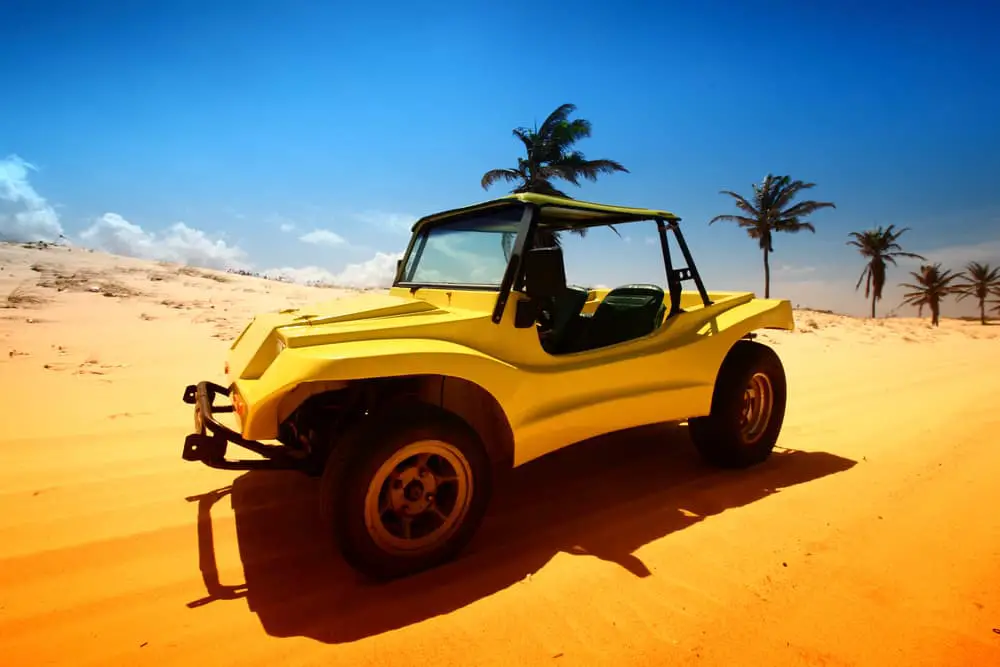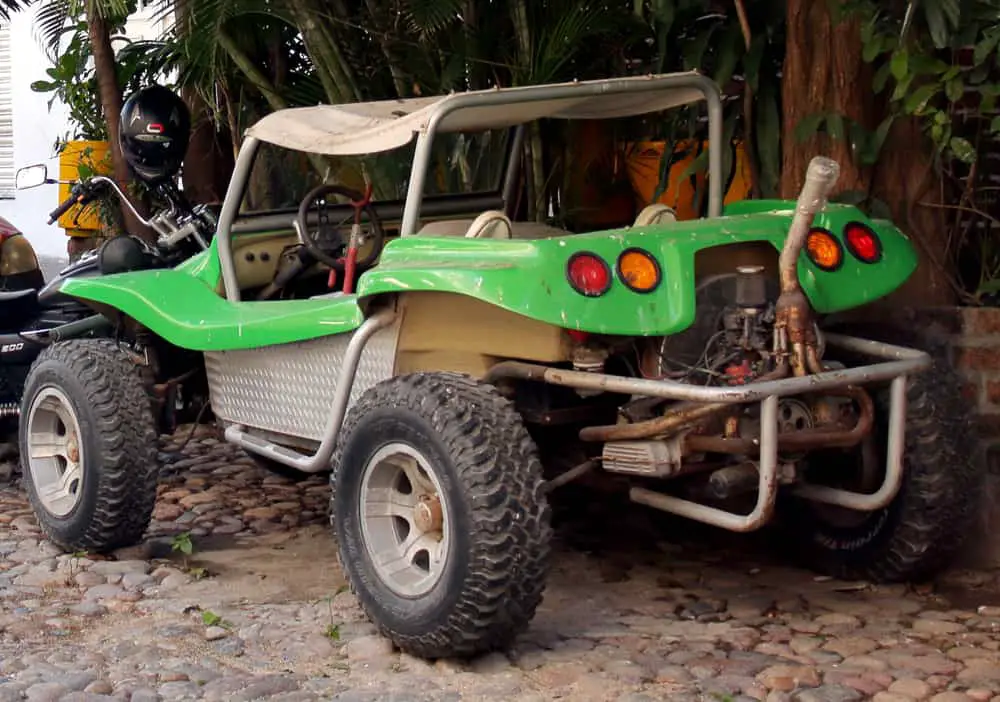
Many of us could never afford a brand-new car or dune buggy, so it is up to us to make sure we know what to look out for before we part with our money. Unfortunately, sellers in this world sell low-quality goods at higher-than-average prices, and due to negligence from the buyer’s side, they often get away with it.
When buying a used dune buggy, it’s essential to do a thorough inspection and to confirm the following is in working order:
- Bring a mechanic to assist with the inspection
- Frame and chassis
- Tires
- Engine
- Gas tank
- Electrical wiring
- Exhaust
- Rust
- Leaking fluids
- Radiator
- Transmission fluid
- Legality
- History report
- Test Drive
Not all of us have the experience and knowledge of what to look for when inspecting a second-hand car. That is why it is crucial to take someone with you to do this inspection, should you not be very clued up about vehicles. This article will discuss some of the more critical inspection areas that need to be checked before you start haggling over price.
What You Should Confirm Before Buying A Used Dune Buggy
Dune buggies are expensive when brand-new; even second-hand ones can come at a steep price. If you are considering buying a used dune buggy, you must inspect the vehicle thoroughly, as this inspection could potentially save you a lot of money in the long run.
Spending your hard-earned cash on a vehicle that is about to cost you more money in the immediate future will be a soul-destroying development, here is how to avoid this from happening:
Bring A Mechanic
The good old doctors of the mechanical world are vital to the inspection process. Bringing a mechanic when inspecting the used dune buggy will put you on the front foot from the start, as he will point out anything alarming. He will help steer you away from purchasing the wrong buggy or help with the price negotiation if you decide that it’s minor elements that need replacing.
If your knowledge of cars is good and you’re comfortable doing the inspection yourself, bring a like-minded friend as a backup. Either way, having a mechanic on your side is the first step in the whole inspection process.
Check The Frame And Chassis
Make sure that the car is parked on level ground before the inspection. A buggy that is leaning to one side can be indicative of the following:
- Bent suspension parts
- Twisted/bent chassis
- Bad spring/tension bar
Inspecting the frame will give some indication of the overall condition of the car; lookout for the following:
- Large cracks?
- Areas of damage?
- Anything hanging from the undercarriage
- Is the frame warped?
- New bolts?
Large cracks and significant areas of damage should alarm you; these cracks will let moisture in and affect the stability of the buggy. Moisture will lead to rust and weaken the buggy frame, the same frame that needs to protect you should you lose control of the vehicle, instantly increasing the risk factor.
New bolts could indicate a recent accident, together with a warped frame. It would be best if you asked the owner to clarify.
Check The Tires
Check the tires as they, if not relatively new, will indicate how the buggy has been used. Use a jack to get the buggy in the air and check for the following:
- Check for uneven wear on the tires, diminished tread depth, or feathering, and this is a giveaway sign that the suspension may need tweaking or replacing shortly.
- Check for any signs of damage on the wheel arches
Check The Engine
Check the engine for the following:
- Dark brown stains
- Any sign of corrosion
- Funny sounds or smells
Dark brown stains on the engine’s block are indicative of a leaky oil pan gasket. Ask the owner for any documentation regarding general maintenance; see it as a good sign if they can provide this information.

Check The Gas Tank
Use a flashlight to aluminate the inside of the gas tank and be on the lookout for:
- Areas of rust
- Areas that are cracked
A gas tank with rusty areas will have to be rebuilt/repaired/replaced as flakes from the rusted areas will mix with the petrol and eventually be injected into your engine, causing massive damage.
Check The Electrical Components
The electrical functionality on some dune buggies is not what it should be. Check the following:
- Headlights
- Indicators
- Brake Light
- Console lights
Check The Exhaust
The exhaust is a tattletale when it comes to engine problems, be on the lookout for the following:
- Greasy grime or black spots on the exhaust are big warning signs
- If there is white vapor blowing out of the exhaust, it could indicate a blown head gasket or burning oil inside the exhaust system, which will need replacing
Check For Rust
A vehicle full of rust should concern you from the get-go. Rust is indicative of metal breaking down, and over time rust will eat through doors, the body, chassis, frame, and floorboards. Check for rust in the following places:
- Underneath the car, door hinges, and door edges
- Check in the trunk for rust by lifting the pad or carpet
- Inspect the floorboards inside the car
- Check under the hood of the car as well as the chassis
- Look for any fluids that may be leaking under the car
Check The Radiator
A radiator hose should not be soft or show any cracks; it should be firm and fitted correctly.
Check The Transmission Fluid
One of the checks you must not forget to check. Transmission fluid should be:
- Pink or red
- Maybe a little darker in appearance in older cars
- Should never be black
- Should never smell burnt
Check The Legality
You get two types of dune buggies:
- Those that are street legal
- Those that are not street legal
Purchasing a dune buggy that is not street legal will force you to buy a trailer as well. The best option is to buy a buggy to drive in the streets and on the dunes.
Check The History Report
A history report includes details on the number of previous owners, actual mileage, details on accidents, VIN verification, and so forth. If you are after a buggy that a used car dealer sells, ask them to provide a report from:
- CARFAX
- Similar service that provides history reports
Check The VIN Number
Check and match the VIN (Vehicle Identification Number) of the for-sale car on history reports, title documents, service records, and on the actual car (behind the driver’s side windshield & the body panels)
Test Drive The Buggy
One of the most important things you can do before buying a dune buggy is to take it for a test drive yourself. When driving the car, take notice of the following:
- Are there any strange noises coming from the engine as you idle or accelerate? Pinging, popping, knocking, and backfiring noises are not sounds of a healthy engine.
- Observe if the car goes through a trembling motion when moving through speeds 45-75mph. If there is trepidation, it might indicate worn ball joints/control arms of the suspension.
- Test the brakes to see how they work; there should be no shudder from low to high speeds.
- Test the clutch, and see that the gears are easy to find and smooth during transmission; there should be no shudder.
- Take the buggy onto the streets and into the dunes and drive it as you would a regular car, making sure to stop and inspect the car’s underside to see if nothing is dripping, and check under the hood to see if everything looks in order.
- How comfortable is the drive? Does it feel if everything is in working order compared to your other cars?
Conclusion
Buying a used dune buggy should not be a game of Russian roulette. Hopefully, this article has given you some guidelines for what you need to check before opening your wallet. Inspecting and test driving the buggy is crucial in determining if it’s in proper working order and the right one for you!
Taking a mechanic along for the inspection will give you peace of mind before you purchase and is highly recommended.
References
6 Tips for Buying a Used Dune Buggy | DoItYourself.com
What to Check When Buying a Used Car – 27 Point Checklist (rawhide.org)


